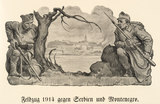Friend or foe? The positions of the southern Slavs in the First World War
-

“Campaign against Serbia and Montenegro”, illustration, 1979
Copyright: Schloß Schönbrunn Kultur-und Betriebsges.m.b.H./Fotograf: Alexander E. Koller
-

Wilhelm Thöny: Serbs – infantry, art print, 1917
Copyright: Wienbibliothek im Rathaus
Partner: Wienbibliothek im Rathaus – Vienna Library in the City Hall
Even before 1914, the Serbs were regarded in the shadow of Austria-Hungary’s aggressive Balkan policy during the Balkan crisis from 1908 as ‘enemies’ of the Habsburg Monarchy. With the outbreak of war they became definitively the prime object of patriotic hate.
Following the failure of the Austrian offensive against Serbia in summer 1914, the ‘Austro-Hungarian’ Serbs, who were suspected in general of being a Serbian ‘fifth column’, were also targeted by the authorities. Serbian organizations were banned, and representatives of Serbian political and economic life, classed as unreliable and potential traitors, were detained in camps or brought to court. Even attacks on Serbs were not prevented, and pogrom-like actions against Serbs by Croat and Muslim militia were ignored by the Austro-Hungarian authorities.
It was not until autumn 1915 that Serbia came under the control of Austria-Hungary and its ally Bulgaria. Serbia was occupied and placed under military administration. A rebellion in the Bulgarian-occupied part of Serbia was brutally put down with 20,000 civilians being killed.
Whereas the Serbs were branded as enemies, most of the Slovene, Croat and Bosnian political scene remained loyal to the war policy of the Habsburg Monarchy. Even though the conciliatory plans for a southern Slav trialism aired before 1914 were finally shelved and the fate of the southern Slavs in the putative post-war order of the Central Powers (in the form of a ‘German central Europe’) was in no way favourable to them, there was no active opposition.
The reason for this was the entry into the war of Italy in 1915. On account of Italy’s expansionist plans in the Adriatic at the expense of the southern Slavs, Vienna now had the full support of the Croat and Slovene public for its war aims. The ‘southern Slav club’ composed of the Slovene, Croat and Serb members of the reconvened Reichsrat in 1917 was basically loyal to the Habsburg Monarchy without foregoing the old demand, ignored by Vienna and Budapest, for the merger of all southern Slav regions into an autonomous state within the Monarchy.
The exiled representatives had a completely different view and they now took the initiative for the creation of an independent southern Slav state. In Paris, the centre of the southern Slav exile policy, a committee was founded in 1914, which was soon dominated by the Serbian position on unification. Some exiled members favoured affiliation with Serbia in the sense of a ‘greater Serbia’, while others called for a federalist model in which the different language groups would have equal rights. These questions of detail were secondary for the people of western Europe, who were relatively ill-informed about the situation in south-eastern Europe. The allowance of the Entente for the demands of its ally Italy were particularly disadvantageous in this regard.
One important factor was the Serbian government in exile on Corfu, where representatives of official Serbia along with a third of the army (150,000 men) had fled after the occupation of the country by the Central Powers. The Corfu Declaration of July 1917 called for the creation of a joint state by the Serbs, Croats and Slovenes as branches of a common Yugoslavian nation. This idea was also increasingly attractive to the ‘Austrian’ southern Slavs – in spite of their fears of greater Serbian aspirations. By summer 1918 representatives of practically all political directions among the southern Slavs were in agreement.
This also brought movement to the domestic political scene. On 6 October 1918 the National Council of Slovenes, Croats and Serbs convened in Zagreb as representatives of all southern Slavs in the Dual Monarchy and began to form structures in preparation for the impending collapse of Austria-Hungary.
Events moved quickly thereafter, taking most people completely by surprise. On 29 October 1918 the State of Slovenes, Croats and Serbs (SHS state), consisting of territories from the collapsing Habsburg Monarchy, was proclaimed. It was a short-lived structure and administered the territories until it joined the Kingdom of Serbia on 1 December 1918. The new state was confirmed under international law as the Kingdom of Yugoslavia at the Treaty of Trianon in 1920.
The rivalries between Serbs, Croats, Bosnians and Slovenes remained ever-present in Yugoslavia and led to nationalist escalation both in the Second World War and the collapse of Yugoslavia in the 1990s.
Translation: Nick Somers
Hösch, Edgar: Geschichte der Balkanländer. Von der Frühzeit bis zur Gegenwart, München 1999
Rumpler, Helmut: Eine Chance für Mitteleuropa. Bürgerliche Emanzipation und Staatsverfall in der Habsburgermonarchie [Österreichische Geschichte 1804–1914, hrsg. von Herwig Wolfram], Wien 2005
Štih, Peter/Simoniti, Vasko/Vodopivec, Peter: Slowenische Geschichte. Gesellschaft – Politik – Kultur, Graz 2008
Suppan, Arnold: Die Kroaten, in: Wandruszka, Adam/Urbanitsch, Peter (Hrsg.): Die Habsburgermonarchie 1848–1918, Band III: Die Völker des Reiches, Wien 1980, Teilband 1, 626–733
-
Chapters
- The Croats in the Habsburg Monarchy
- ‘Loyal rebels: the role of the Croats in the 1848 revolution
- The question of autonomy: the Croats caught between Vienna and Budapest
- The Serbs in the Habsburg Monarchy
- ‘Serbs all and everywhere’: the Serb national programme
- The Bosnians in the Habsburg Monarchy
- Sharia under the Double Eagle: Austria-Hungary and the Bosnian Muslims
- From Illyrism to Yugoslavism: competing concepts for a southern Slav nation
- Friend or foe? The positions of the southern Slavs in the First World War






